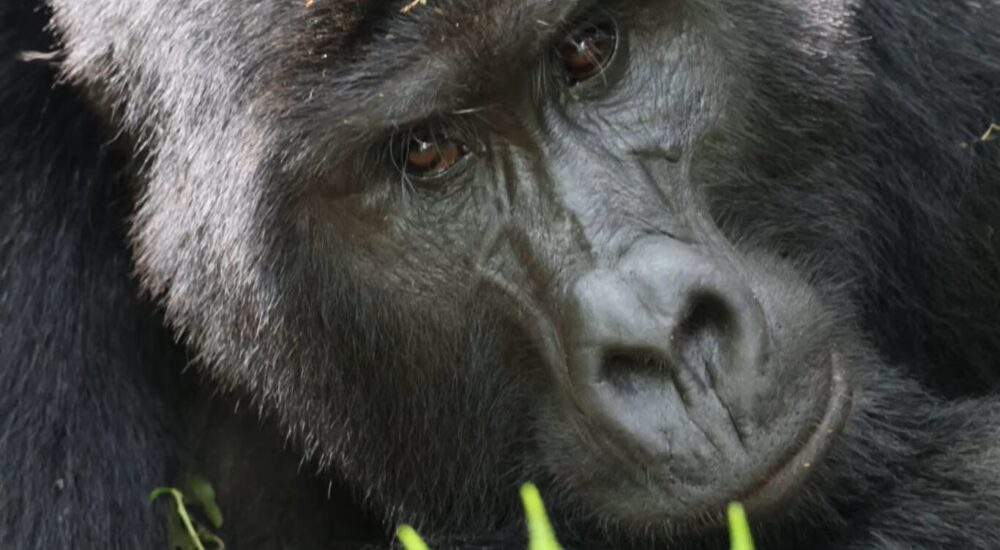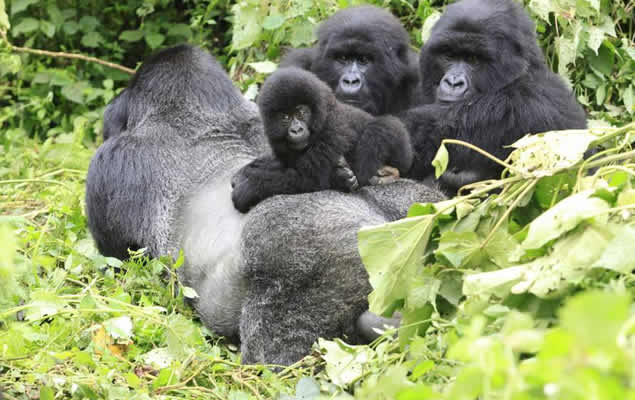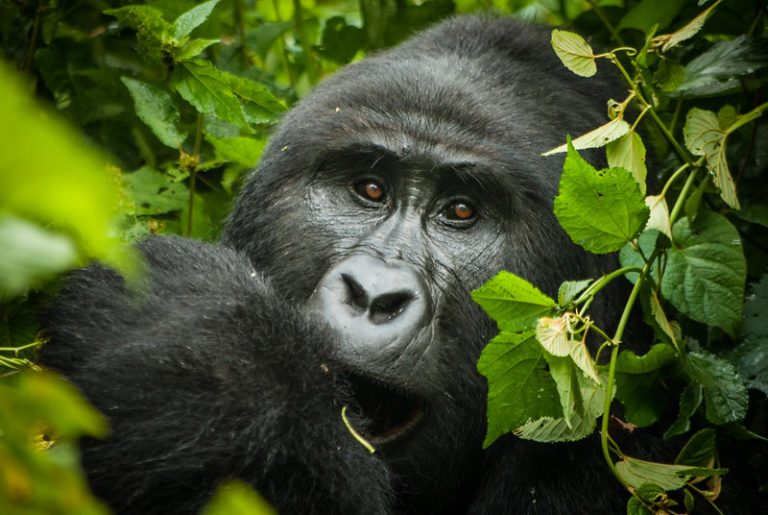What is Gorilla Trekking? Best Destinations for Family-Friendly Gorilla Trekking Preparing for Your Gorilla…
Gorilla Trekking Altitude Acclimatization and Elevation
Gorilla Trekking Altitude Acclimatization and Elevation, Any visitor who has been gorilla trekking has a different idea of what it is all about. There are many things that can go wrong on the walk to see a group of mountain gorillas in the wild. One of these is the high altitude. When people go on gorilla tours in Uganda, Rwanda, or the Democratic Republic of the Congo, they usually get altitude sickness above 2500 meters. Other guests are more likely to get sick even at lower elevations.
A lot of mountain gorillas live at high elevations, between 2200 and 3000 meters. This could make it hard for people to find a gorilla family. This means that you need to do some good planning before the walk so that you can get used to the tough, steep hills in the gorilla environment. There are two different areas of Africa where mountain gorillas live. One is the Virunga Conservation Area, which includes Volcanoes National Park in Rwanda, Virunga National Park in the Democratic Republic of the Congo, Bwindi Impenetrable National Park, and Mgahinga Gorilla National Park in Uganda.
To see mountain gorillas, tourists have to hike through hilly areas, which is hard work. In Rwanda, you have to be ready to walk through thick vegetation and at least 2500m above sea level to see a family of mountain gorillas. Volcanoes National Park (Parch Nationale des Volcans) is in the Ruhengeri area, which is about two to three hours’ drive from Kigali and is the only place in Rwanda where you can go on a mountain gorilla trek.
There are a lot of hills on this trail, and there are parts with well-marked trails. It might be really hard; you might have to hike for hours or even the whole day in hot, high-altitude conditions. Please be as fit as you can for this. Even though the air isn’t high enough to make people sick, hikers may have trouble breathing and need to stop many times before they see a gorilla family. This is true for both older and younger walkers with more energy.
Gorilla Trekking: Getting Used to High Altitudes and Elevation
Even though severe and repeated cases of altitude sickness don’t usually happen, the trip will definitely be longer and harder because of the altitude. The ranger guides are very good at what they do, and they always walk at the pace of the slowest person in the group during their amazing hour in the wild with mountain gorillas. There are places where mountain gorillas live that are very high up and might be hard to get to based on the region and national park. Some gorilla families and places are harder to trek than others, so you may need to do some work to get used to the rough, steep hills before your journey.
Find Out More About Gorilla Trekking in Uganda, Rwanda, and the Congo Right Now.
There are a little more than 1,000 mountain gorillas left in the world. About 300 live in Volcanoes National Park in Rwanda, 100 live in Virunga National Park in the Democratic Republic of the Congo, and over 600 live in Mgahinga Gorilla and Bwindi Impenetrable Forest National Parks in Uganda.
A normal day of gorilla trekking starts at 7:00 a.m. with a meeting at the park headquarters. During this briefing, the head guide gives a short description of the gorilla family’s given habitat and the mountain gorilla group. They also go over basic rules and laws that must be followed during the hunt for this gorilla family.
A gorilla walk usually starts between 7:30 and 8:00 a.m. and lasts for 1 to 8 hours, based on how quickly a group of mountain gorillas is found. On the gorilla trek, you’ll see a lot of different types of montane landscapes, such as bamboo farms, open grasslands, wetlands, and heath. When it rains, the ground may be rough, steep, and slippery. Soon after the walk, there is a one-on-one meeting with a lively gorilla family consisting of a huge silverback, fun teens, and caring moms.
Spend an hour with them and enjoy the beauty of watching them play, hunt, rest, and do their daily tasks. The lead silverback will quickly jump out of the bushes on a good day and pound their check, showing that it has complete power over the whole family. This is a one-of-a-kind feeling that will make your heart race more than once and give you memories that will last a lifetime.
You need to have a lot of energy to go gorilla hiking in deep rain forests on steep slopes. This amazing primate trip is split into two parts. The first part is a short walk from the parking lot to the rainforests and the national park borders. This walk can take anywhere from 30 minutes to an hour, based on how fast you walk and where the gorilla family is.
In the other part, you go into the forest to look for a group of these huge monsters that blend in with the plants. A well-trained and professional park guard guide goes with you. Based on the group you are following, it is usually easy to tell what the first part of the trek is because it goes through gentle terrain and doesn’t require much energy.
But if you want to watch the Susa A family, you might need more time to hike because the high elevation makes it hard on the body. The same is true for the Nkuringo group in Bwindi National Park, which has difficult treks.
The second part is usually harder, and you can’t tell when it will happen because it depends on where the gorillas are during the day and how steep the land is. Another thing that decides how hard the terrain is is how thick the plants are that you have to bend over and crawl through to check for gorillas. This step could take anywhere from two to eight hours, based on how fast you walk and the other factors listed above.
You need to have a lot of energy to go gorilla hiking in deep rain forests on steep slopes. This amazing primate trip is split into two parts. The first part is a short walk from the parking lot to the rainforests and the national park borders. This walk can take anywhere from 30 minutes to an hour, based on how fast you walk and where the gorilla family is.
In the other part, you go into the forest to look for a group of these huge monsters that blend in with the plants. A well-trained and professional park guard guide goes with you. Based on the group you are following, it is usually easy to tell what the first part of the trek is because it goes through gentle terrain and doesn’t require much energy.
But if you want to watch the Susa A family, you might need more time to hike because the high elevation makes it hard on the body. The same is true for the Nkuringo group in Bwindi National Park, which has difficult treks.
The second part is usually harder, and you can’t tell when it will happen because it depends on where the gorillas are during the day and how steep the land is. Another thing that decides how hard the terrain is is how thick the plants are that you have to bend over and crawl through to check for gorillas. This step could take anywhere from two to eight hours, based on how fast you walk and the other factors listed above.
In addition, other factors like age and level of physical health need to be taken into account. You have to be pretty fit and over 40 to follow the Susa group. If you want to hike through this group, it’s harder and takes more energy than hiking through the Sabyinyo family or through groups like Hirwa, Kwitonda, and Agashya. Amahoro and Umubano might also need more energy. Most importantly, you can start training and getting the most out of your property before the real trip. Before the trek, this will help you get used to the high altitude. Then, the trip will seem easy.
During the wet season, hiking can be hard because you have to go up and down steep hills and through muddy and slippery areas. It’s important not to forget how tiring high altitude can be, since treks happen between 2500 and 3000 meters. During the wet season, hiking can be hard because you have to go up and down steep hills and through muddy and slippery areas. It’s important not to forget how tiring high altitude can be, since treks happen between 2500 and 3000 meters.
Some people who go on gorilla safaris have a hard time, even if the spot is not at a high elevation that could cause altitude sickness. In general, you might have to stop a few times before you see a group of mountain gorillas on a gorilla walk. Most people don’t know how long the gorilla hike is, but the workout takes between 2 and 6 hours.
This could be different based on how fast the trekkers walk, where they look for gorillas, the ecosystem, and other important factors. These factors affect everyone, not just old people. They even affect young and busy people. This is why you need to make sure you can handle high altitudes on your gorilla climbing trip in Rwanda.
It is harder to go on a trek to see mountain gorillas than it is to go on a game drive in Akagera National Park. The elevation makes the whole trip more beautiful, but if you’re ready, you won’t have to worry about things like altitude sickness. On all gorilla treks, tourists are followed by a trained park guide.
As you move through the forest, the guide makes sure to stay within everyone’s trekking space so that no one gets lost. It’s also important to let your tour guide or park ranger know about your health as soon as possible. This will help them put you in the right gorilla group on the day you learn how to behave while walking with gorillas.
On the other hand, mountain gorillas are great to hang out with. A trek to see them in the wild is an adventure you’ll never forget. These rare apes can only be found in the Virunga area of Mgahinga Gorilla National Park, Volcanoes National Park (Parch Nationale des Volcans) in Rwanda, and Virunga National Park.
About half of them live in Bwindi Impenetrable National Park. The two groups of mountain gorillas that live and do well in these two places now number about 1063 people. In Rwanda, you can go on a gorilla trek in any of the ten gorilla groups that live in Volcanoes National Park: Bwenge, Ugenda, Kwitonda, Susa A, Agashya, Umubano, Amahoro, Hirwa, Karisimbi (Susa B), and Sabyinyo.
For US$1,500 per person, you can reserve a gorilla pass for Rwanda. Our reservation staff can do this for you and also help you plan the best gorilla trip possible in Rwanda. When planning a gorilla trekking trip in Uganda, Rwanda, or the Democratic Republic of the Congo, make sure to book your gorilla permit ahead of time because they are in high demand, especially during peak seasons. Also, pick the right months to travel and bring the right clothes to keep from getting altitude sickness while trekking gorillas.
When is the best time to go hiking with gorillas in Uganda, Rwanda, and the Congo?
The dry seasons are from mid-December to early February and from June to September. These are the best times to go climbing. If it rains in November or March–May, don’t let that stop you. You’ll have the forests, mountains, guides, and gorillas all to yourself.
How old do you have to be to go chimp trekking?
Visitors must be at least 15 years old to go gorilla hiking, and each gorilla group can only take 8 people per day.
What should you bring with you to Uganda, Rwanda, or the Congo to go gorilla trekking?
Two face masks and hand wipes
A good jacket that is light and waterproof
pants, a t-shirt with long sleeves, and extra socks
A set of gloves for hiking
A pair of camping boots that are light and waterproof
A cream that keeps bugs away
S Sunblock
Foods that give you energy
Use compostable tissue or toilet paper
Backpack that won’t get wet
Walking sticks or hiking poles
Water bottle that can be filled up again
There are rules and laws that you must follow when you go gorilla hiking.
Gorilla trekking rules and laws are basic guidelines set up by gorilla park officials to make sure that visitors and gorillas can get along during the gorilla trekking experience. These principles include
People who are getting used to the jungle should stay together so they don’t get lost.
Stay at least 7 meters away from the mountain gorillas.
When you’re near the mountain gorillas, you can’t eat or smoke.
Mountain gorillas are dangerous animals, so don’t touch them.
People who are sick with colds like the flu, cough, and others should not take part in the habituation process because mountain gorillas can get human diseases.
People shouldn’t make noise when they’re near the gorillas.
When taking pictures, visitors shouldn’t use flash cameras because it will take their attention away from what they’re doing.
Keep your voice down at all times. You can, however, ask the guides questions.
You should stay together when you’re near the mountain gorillas.
Mountain Gorillas sometimes charge. Carefully crouch down, following the guide’s lead. No matter what kind of monkey it is, never look it in the eyes. If you try to run away while the gorillas are still there, you might make it more likely that you will be attacked.
If you are already in the park and are sick or have a disease that can spread, please offer to stay behind. You will be scheduled for a new visit, or your money will be returned to you in line with our reservation rules.
To sum up, if you get altitude sickness easily, don’t forget to bring the medicine your doctor gave you before you go on your gorilla trekking trip. Remember to work out or train before your gorilla trekking trip so that you can easily get used to the long, hard treks and high elevations you will be going to see gorillas.


